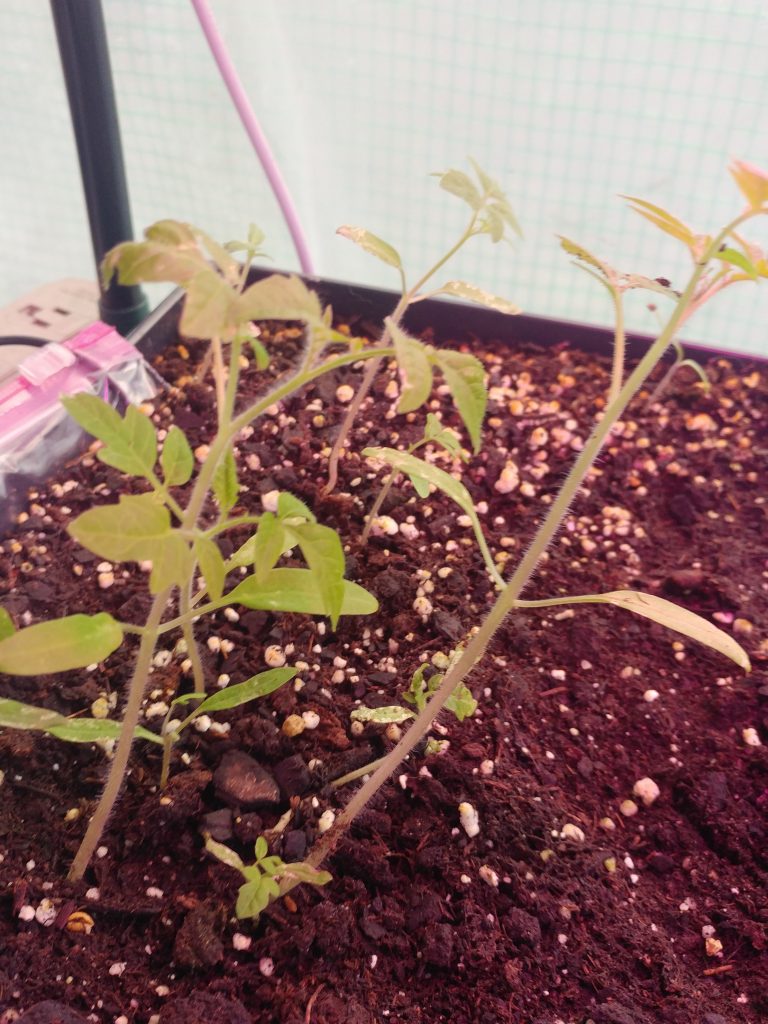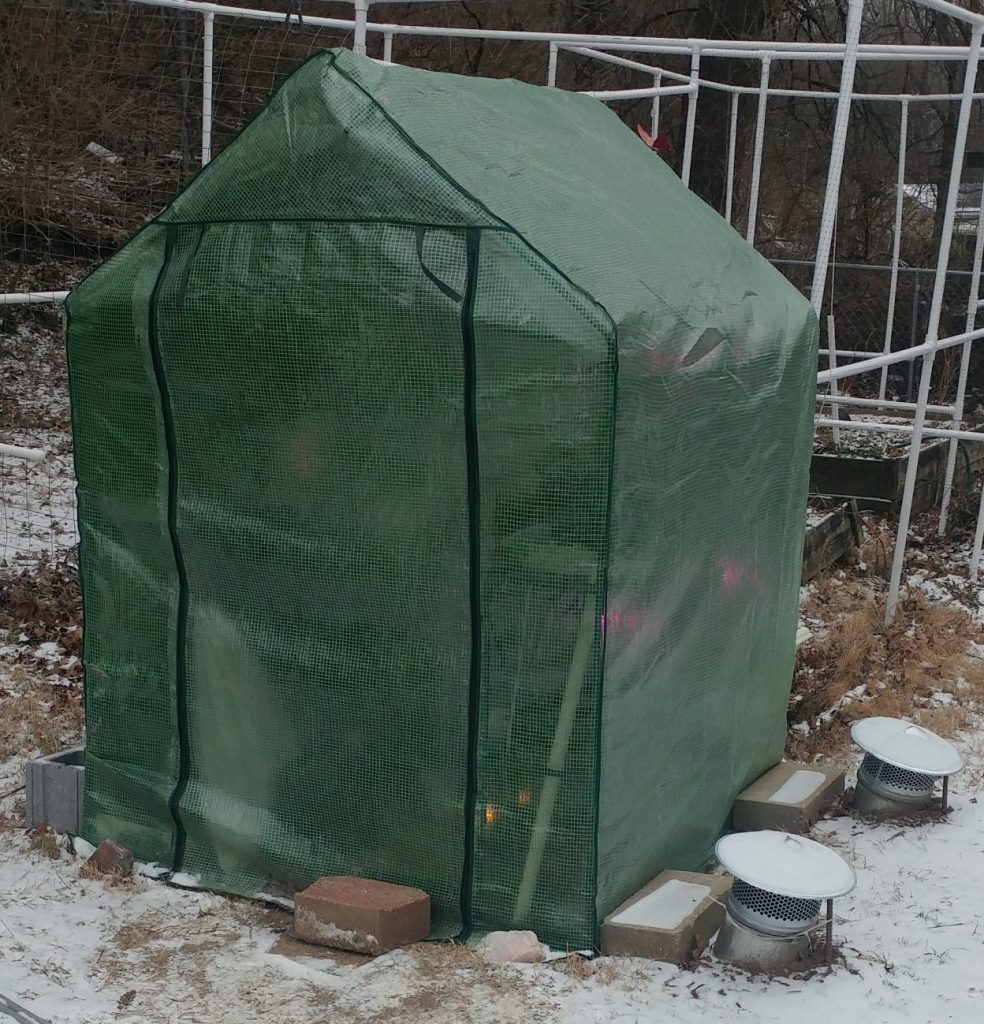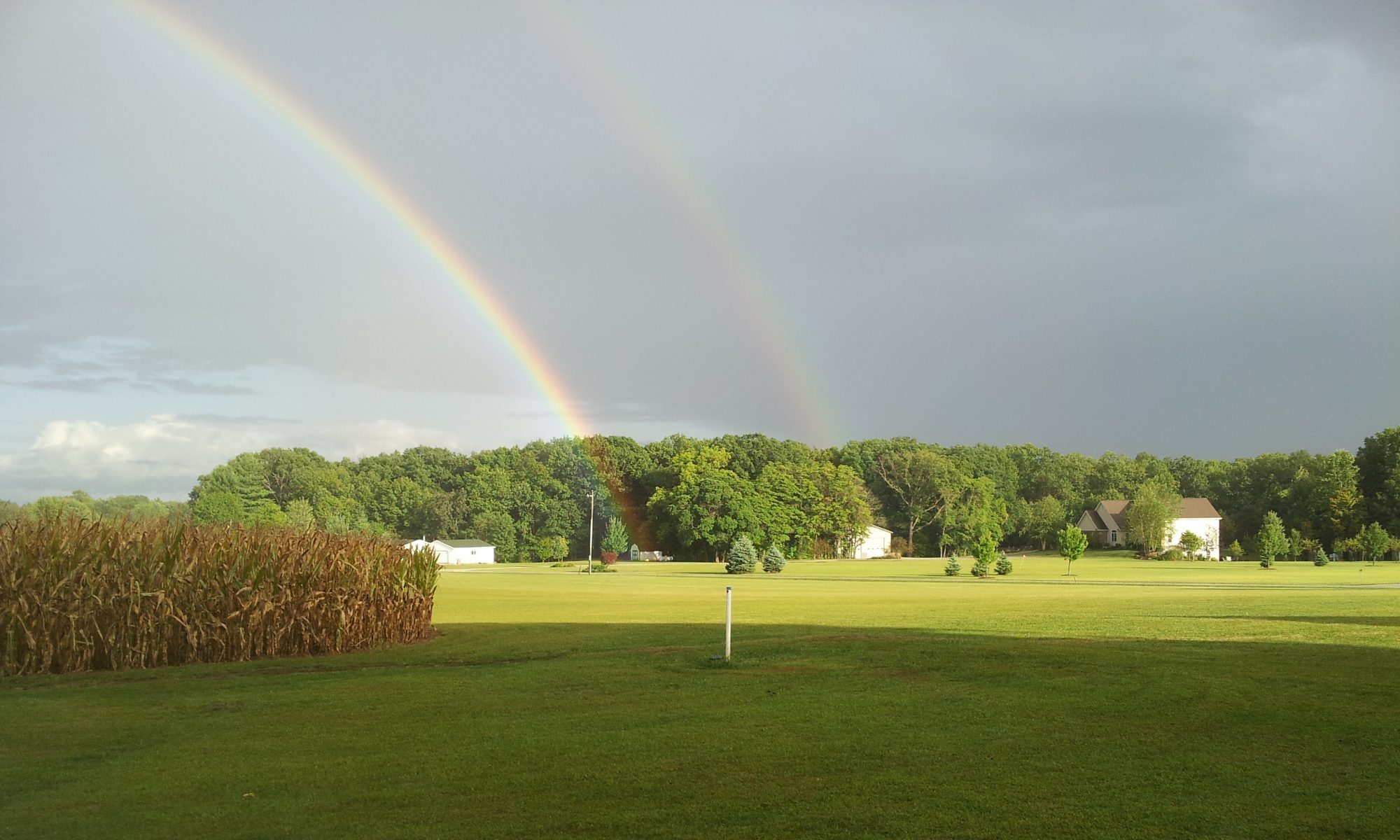Welcome to February 7th, 2021. I woke up to a cold and blustery 6F (six degrees Fahrenheit) outside temperature with a -6F wind chill this morning. That’s 5 degrees colder than the local meteorologists had predicted midday yesterday. My first thought of the morning concerned my greenhouse and its delicate plants — tomato plant seedlings, Marigold seedlings, Mums, Rosemary, Peppermint, and a Gerber Daisy — inside. The lettuce was the only plant in the greenhouse that would survive below freezing temperatures. Last night was the test. Did I plan for cold weather appropriately enough? Or did my plants freeze?

Running out to check on the greenhouse, I unzipped the polypropylene cover and peered inside. In the frigid 6F morning air, my face was met with a blast of 72F air.
Yippee!! I was successful. My plants survived!!
Greenhouse 1.0
My greenhouse, affectionately referred to, by me, as Greenhouse 1.0, maintained its 72F temperature overnight. Actually, it keeps the temperature between 67.1F and 72.3F. But not by itself. It has help. I bought this greenhouse on Amazon.com in early October 2020. For 3 months, I’ve prepared to deal with single degree (F) overnight low temperatures. Last night was the first time since I erected this greenhouse that we actually had single digit weather. Over the next week, we expect at least 10 more days of similar weather.

A Series of Posts
And so begins a series of blog posts about my greenhouse adventure. The first few posts will be definitive — this is what I did, and why — to get to the current configuration. Then, I will post my challenges as I face them, before I even have a solution. I will welcome your ideas and suggestions about how to proceed. I want to collaborate with my readers. For me, this is a learning experience and it’s fun. Why not join me on this adventure?
This is not a commercial venture. I have no intention to make it a commercial venture. Money is not unlimited. In-fact, I’d rather do something effective on a shoestring budget that I learn from, than spend big bucks for a complete system that I don’t need to think about. For me, it’s not about growing plants, but figuring out what I have to do to grow plants.
The Purpose
Greenhouse 1.0 was purchased with a specific purpose in mind: Grow lettuce, spinach, and swiss chard over the Winter in my east central Missouri backyard, in the heart of suburbia. The more I learned, the more I wanted to do. Today, I’m thrilled at successfully maintaining a 66 degree temperature differential between the inside temperature and the outside temperature with a 12mph wind. Looking to the future, we have hatched a plan for a bigger greenhouse — Greenhouse 2.0 — where my 6′ 5″ tall self can wander around inside of without hitting my head. Additionally, my wife would like to be able to work in the greenhouse while I’m in there. Greenhouse 1.0 isn’t big enough for both of us to work inside at the same time, and my head either drags on the roof, or I’m bent at the middle. Further, my subdivision has a rule — no out buildings. But many of my neighbors have sheds and such, which violates that rule too. Still, Greenhouse 2.0 will be noticeably bigger than most of those sheds. I’d like to avoid getting a ticket from the home owners’ association.
Who Am I?
My background is in Information Technology. I have a Bachelor’s of Science degree in Computer Science and Mathematics from a long time ago. I have been writing computer code for 40 years. I owned a computer consulting company for 14 years; I worked as the IT Manager, reporting to the CFO, for a 200 employee eating disorder clinic; I worked as the database expert for a petroleum company; I worked for a brewery developing internal software; and I developed flight software for a military contractor for various fighter jet avionics programs; and much more. Most recently, I am finishing the development of a WordPress plugin, which I will make available, for sale, on Freemius.com in the next few weeks.
For gardening, for greenhouse growing, I have zero experience beyond building my wife’s raised gardens, building enclosures (see white piping in the background of the above picture) to repel the deer, tilling the soil each Spring, helping her plant and water her plants, and watching for ripe tomatoes. Gardening is my wife’s hobby, not mine. But me? I like a challenge. And in 2020, the challenge was to find a way to grow vegetables over the winter, and not in the house.
We have lived in our current home for 27 years. For the first 10 to 15 years, we grew a garden in pots on the back patio. Then we made some space and built two raised gardens: 8′ x 4′ x 22″. Everything was fine, until the deer discovered the gardens. In a single year, they forced us to replant the garden 3 times before we just gave up.
Garden Enclosure 1.0
The following year, we erected 10′ pieces of rebar as fence posts and wrapped the whole thing with wildlife netting. For the most part, except for the vertical pieces of rebar, the enclosure was invisible to the neighbors until it got covered with leaves in the fall, or it got covered with snow and ice in the Winter. Unfortunately, the deer couldn’t see it either. They would get their hooves or antlers entangled in the netting and rip it to shreds once or twice each month. Fortunately for our garden, they would just run off after getting free, instead of staying to feast on the now-exposed garden.
If the deer weren’t enough, our own wildlife would make holes in the netting occasionally too. For 18 years, 2002 to 2020, we worked for a local Golden Retriever Rescue organization. The organization closed and disbanded due to lack of volunteers in early 2020. I worked events: fundraising events, public education events, and more. My wife and I fostered 36 Golden Retrievers in our home. Some stayed just a week or two. Others stayed as much as 6 months as they were rehabilitated and readied for adoption into their forever homes. 4 stayed forever. 2 of those 4 have moved on to the Rainbow Bridge — Jasper @ 14.5 years in 2017 and Amos @ 14.5 years in 2019. Remaining are Cooper, who arrived at 18 months old as a terror, and Luke who arrived at 6 months old. Today, Cooper is 11 years old and Luke is 3 years old. Cooper is adept at making new holes in the netting.
Garden Enclosure 2.0
In the Spring of 2020, we decided to replace our rebar and netting enclosures. I built the new enclosures with 1.5″ PVC piping and deer netting. The deer still couldn’t see the netting, but the white PVC piping was clearly visible. The netting lasted the whole season. The white PVC piping kept the deer from getting too close. Cooper, however, punched a hole in the netting after the end of the growing season to chase a ground squirrel. I have to remember to fix that before the start of the Spring 2021 growing season.
Thinking of the Future
While building the new enclosures, we started thinking ahead to Winter 2020/2021. We thought we could turn it into a greenhouse by covering the outside with clear plastic and gluing plastic to the inside of the PVC pipes to create a dead-air-space, which would function, at least a little, as insulation. It is the concept of a dead-air-space which makes double- and triple-paned windows work. Window manufacturers experiment with different gases to use between the panes, but for my purposes, we’d just use normal air.
As Summer 2020 faded into the Fall, it was time to implement our plan and convert our Summer enclosures to Winter greenhouses. Wrapping the exterior of the enclosure with clear plastic would be easy. Unfortunately, adding an insulative inner layer of plastic to create the dead-air-space was proving to be a nightmare. Temperatures were cool and the glue didn’t want to stick to PVC. At this point, I also started asking the question: How would we keep it warm? And the follow-on question: how warm would we have to keep it? Both were excellent questions. Both needed to be answered before continuing. As it turned out, the answers to both questions, would also dictate the size of the greenhouse and what it would look like.
In the next post in this series, I will cover what Greenhouse 1.0 would become, why, how I kept it warm, and what other challenges faced us the first week.
© 2021, PaulSwarthout. All rights reserved.

